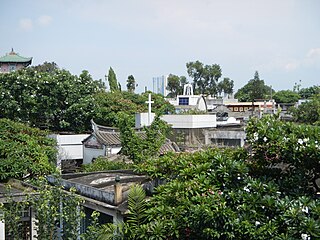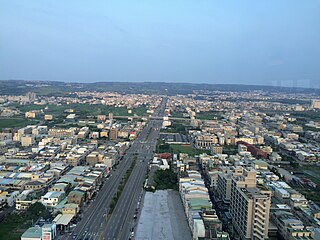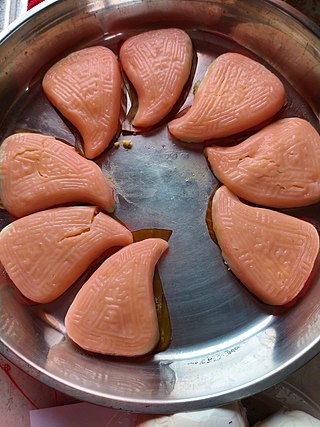
Machi is a Taiwanese hip hop group that has nine active members, with two additional members on a hiatus from group activities.

Wugu District is a suburban district in the western part of New Taipei City in northern Taiwan. It has an area of 34.86 km2 and a population of 90,465 people (2022).

Chang Fei (Chinese: 張菲; pinyin: Zhāng Fēi; Pe̍h-ōe-jī: Tiuⁿ Húi ; born Chang Yan-ming is a Taiwanese singer and television personality.

A kopitiam or kopi tiam is a type of coffee shop mostly found in parts of Indonesia, Malaysia, Singapore, Brunei and Southern Thailand patronised for meals and beverages, and traditionally operated by the Chinese community of these countries. The word kopi is an Indonesian and Malay term for coffee and tiam is the Hokkien/Hakka term for shop. Traditional kopitiam menus typically feature simple offerings: a variety of foods based on egg, toast, kaya, plus coffee, tea, Horlicks and Milo. Modern kopitiams typically feature multiple food stalls that offer a wider range of foods.

Pe̍h-ōe-jī, sometimes known as Church Romanization, is an orthography used to write variants of Hokkien Southern Min, particularly Taiwanese and Amoy Hokkien, and it is widely employed as one of the writing systems for Southern Min. During its peak, it had hundreds of thousands of readers.

is a county of the prefecture-level city of Quanzhou, in southern Fujian province, People's Republic of China. It lies adjacent to and directly north of Xiamen city.

Taiwan Shoufu University is a private university in Madou District, Tainan, Taiwan, and runs independently with 2 hotels in Kaohsiung.

Yu Dayou (1503–1579), courtesy name Zhifu, art name Xujiang, was a Chinese martial artist, military general, and writer best known for countering the wokou pirates along China's southeastern coast during the reign of the Jiajing Emperor in the Ming dynasty.
The daguangxian is a Chinese bowed two-stringed musical instrument in the huqin family of instruments, held on the lap and played upright. It is used primarily in Taiwan and Fujian, among the Hakka and Min Nan people.

The Manila Chinese Cemetery is the second oldest cemetery in Manila after La Loma Cemetery. The cemetery includes Christian, Buddhist and Taoist burials. The present-day cemetery is a vaguely trapezoidal area of about 54 hectares with an irregular network of roads its old pre-war part along Rizal Avenue Extension, reflecting its gradual evolution and expansion. Meanwhile, the post-war portion has three major roads bisected by minor roads, aligned NW to SE. Matandang Sora, coming from the main entrance in Felix Huertas going towards Chong Hock Temple, is the main road today. Before the Pacific War the main entrances faced Avenida Rizal. This northwestern is the oldest and most historically significant part of the cemetery. The cemetery was witness to many executions during World War II. Among them were Girl Scouts organizer Josefa Llanes Escoda, Filipino Brigadier General and hero during World War II and Boy Scouts of the Philippines charter member Vicente Lim, literary geniuses Rafael Roces and Manuel Arguilla, star athlete-turned-guerrilla spy Virgilio Lobregat, and Chinese Consul General Yang Guangsheng. Apolinario Mabini was also buried in the cemetery before his remains were transferred to Batangas on July 23, 1956.

Mudan Township (Chinese: 牡丹鄉; pinyin: Mǔdān Xiāng; Wade–Giles: Mu3-tan1 Hsiang1; Pe̍h-ōe-jī: Bó͘-tan-hiong) is a mountain indigenous township in Pingtung County, Taiwan. The main population is the Paiwan people of the Taiwanese aborigines.

The Tainan University of Technology, also known as Tainan Tech, is a private university serving approximately 10,000 students in the Tainan metropolitan area in southern Taiwan. The main campus sits in Yongkang District of Tainan.

Dongshan District is a rural district in Tainan, Taiwan. It was formerly called Hoansia.

Baihe District is a district located in Tainan, Taiwan. It is known for its hot springs and lotus farming. The town borders Chiayi County to the north and east, Dongshan District to the south, and Houbi District to the west. Some indigenous Siraya people live here, although their lifestyles and traditions were almost replaced by Han Chinese culture.

Shalu District is a suburban district in central Taichung City, Taiwan.

Chung Shan Medical University is a medical university located in South District, Taichung, Taiwan. Chung Shan Medical University Hospital is affiliated with the university.

The official romanization system for Taiwanese Hokkien in Taiwan is locally referred to as Tâi-uân Bân-lâm-gí Lô-má-jī Phing-im Hong-àn or Taiwan Minnanyu Luomazi Pinyin Fang'an, often shortened to Tâi-lô. It is derived from Pe̍h-ōe-jī and since 2006 has been one of the phonetic notation systems officially promoted by Taiwan's Ministry of Education. The system is used in the MoE's Dictionary of Frequently-Used Taiwan Minnan. It is nearly identical to Pe̍h-ōe-jī, apart from: using ts tsh instead of ch chh, using u instead of o in vowel combinations such as oa and oe, using i instead of e in eng and ek, using oo instead of o͘, and using nn instead of ⁿ.
National Taipei University of Business, formerly known as National Taipei College of Business, is a national co-educational college located in Taipei City and Taoyuan City, Taiwan.

Red peach cake, also known as rice peach cake and rice cake is a small teardrop shaped Teochew kuih with soft sticky glutinous rice flour skin wrapped over a filling of glutinous rice, peanuts, mushrooms, and shallots. The skin of the kuih is often dyed pink, and shaped with a wooden mould before steaming. The cake is native to the Teochew people.

The Office of the President is an organ of the Republic of China (Taiwan) that handles the general administrative affairs of the President and the Vice President. The office, together with the National Security Council, serve as the two advisory agencies to the President.


















